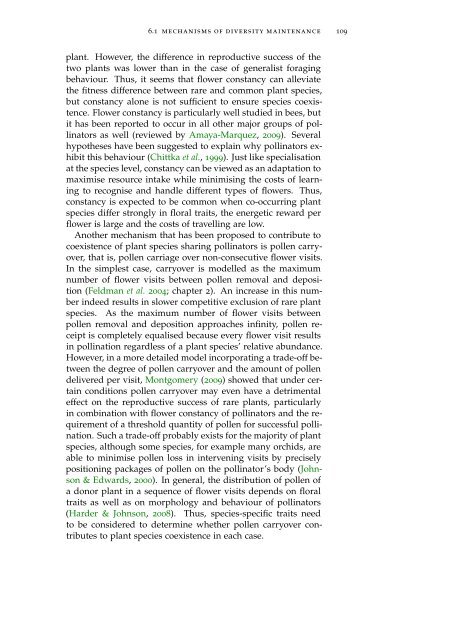Linking Specialisation and Stability of Plant ... - OPUS Würzburg
Linking Specialisation and Stability of Plant ... - OPUS Würzburg
Linking Specialisation and Stability of Plant ... - OPUS Würzburg
You also want an ePaper? Increase the reach of your titles
YUMPU automatically turns print PDFs into web optimized ePapers that Google loves.
6.1 mechanisms <strong>of</strong> diversity maintenance 109<br />
plant. However, the difference in reproductive success <strong>of</strong> the<br />
two plants was lower than in the case <strong>of</strong> generalist foraging<br />
behaviour. Thus, it seems that flower constancy can alleviate<br />
the fitness difference between rare <strong>and</strong> common plant species,<br />
but constancy alone is not sufficient to ensure species coexistence.<br />
Flower constancy is particularly well studied in bees, but<br />
it has been reported to occur in all other major groups <strong>of</strong> pollinators<br />
as well (reviewed by Amaya-Marquez, 2009). Several<br />
hypotheses have been suggested to explain why pollinators exhibit<br />
this behaviour (Chittka et al., 1999). Just like specialisation<br />
at the species level, constancy can be viewed as an adaptation to<br />
maximise resource intake while minimising the costs <strong>of</strong> learning<br />
to recognise <strong>and</strong> h<strong>and</strong>le different types <strong>of</strong> flowers. Thus,<br />
constancy is expected to be common when co-occurring plant<br />
species differ strongly in floral traits, the energetic reward per<br />
flower is large <strong>and</strong> the costs <strong>of</strong> travelling are low.<br />
Another mechanism that has been proposed to contribute to<br />
coexistence <strong>of</strong> plant species sharing pollinators is pollen carryover,<br />
that is, pollen carriage over non-consecutive flower visits.<br />
In the simplest case, carryover is modelled as the maximum<br />
number <strong>of</strong> flower visits between pollen removal <strong>and</strong> deposition<br />
(Feldman et al. 2004; chapter 2). An increase in this number<br />
indeed results in slower competitive exclusion <strong>of</strong> rare plant<br />
species. As the maximum number <strong>of</strong> flower visits between<br />
pollen removal <strong>and</strong> deposition approaches infinity, pollen receipt<br />
is completely equalised because every flower visit results<br />
in pollination regardless <strong>of</strong> a plant species’ relative abundance.<br />
However, in a more detailed model incorporating a trade-<strong>of</strong>f between<br />
the degree <strong>of</strong> pollen carryover <strong>and</strong> the amount <strong>of</strong> pollen<br />
delivered per visit, Montgomery (2009) showed that under certain<br />
conditions pollen carryover may even have a detrimental<br />
effect on the reproductive success <strong>of</strong> rare plants, particularly<br />
in combination with flower constancy <strong>of</strong> pollinators <strong>and</strong> the requirement<br />
<strong>of</strong> a threshold quantity <strong>of</strong> pollen for successful pollination.<br />
Such a trade-<strong>of</strong>f probably exists for the majority <strong>of</strong> plant<br />
species, although some species, for example many orchids, are<br />
able to minimise pollen loss in intervening visits by precisely<br />
positioning packages <strong>of</strong> pollen on the pollinator’s body (Johnson<br />
& Edwards, 2000). In general, the distribution <strong>of</strong> pollen <strong>of</strong><br />
a donor plant in a sequence <strong>of</strong> flower visits depends on floral<br />
traits as well as on morphology <strong>and</strong> behaviour <strong>of</strong> pollinators<br />
(Harder & Johnson, 2008). Thus, species-specific traits need<br />
to be considered to determine whether pollen carryover contributes<br />
to plant species coexistence in each case.
















